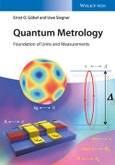This book introduces and explains the applications of modern physics concepts to metrology, the science and the applications of measurements. A special focus is made on the use of quantum standards for the realization of the forthcoming new SI (the international system of units). The basic physical phenomena are introduced on a level which provides comprehensive information for the experienced reader but also provides a guide for a more intense study of these phenomena for students.
Table of Contents
Foreword IX
Preface XI
List of Abbreviations XIII
Color Plates XVII
1 Introduction 1
2 Some Basics 5
2.1 Measurement 5
2.1.1 Limitations of Measurement Uncertainty 5
2.1.1.1 The Fundamental Quantum Limit 6
2.1.1.2 Noise 7
2.2 The SI (Système International d'Unités) 10
2.2.1 The Second: Unit of Time 11
2.2.2 The Meter: Unit of Length 14
2.2.3 The Kilogram: Unit of Mass 15
2.2.4 The Ampere: Unit of Electrical Current 17
2.2.5 The Kelvin: Unit of Thermodynamic Temperature 18
2.2.6 The Mole: Unit of Amount of Substance 19
2.2.7 The Candela: Unit of Luminous Intensity 20
3 Laser Cooling, Atomic Clocks, and the Second 23
3.1 Techniques for Laser Cooling 25
3.1.1 Doppler Cooling, Optical Molasses, and Magneto-Optical Traps 26
3.1.2 Cooling Below the Doppler Limit 28
3.1.3 Optical Lattices 29
3.1.4 Ion Traps 30
3.2 The Cs Fountain Clock 32
3.3 Optical Clocks 36
3.3.1 Femtosecond Frequency Combs 38
3.3.2 Neutral Atom Clocks 43
3.3.3 Atomic Ion Clocks 46
3.3.4 Possible Variation of the Fine-Structure Constant, α 49
4 Superconductivity, Josephson Effect, and Flux Quanta 61
4.1 Josephson Effect and Quantum Voltage Standards 61
4.1.1 Brief Introduction to Superconductivity 61
4.1.2 Basics of the Josephson Effect 63
4.1.2.1 AC and DC Josephson Effect 64
4.1.2.2 Mixed DC and AC Voltages: Shapiro Steps 65
4.1.3 Basic Physics of Real Josephson Junctions 66
4.1.4 Josephson Voltage Standards 68
4.1.4.1 General Overview: Materials and Technology of Josephson Arrays 69
4.1.4.2 DC Josephson Voltage Standards: The Conventional Volt 70
4.1.4.3 Programmable Binary AC Josephson Voltage Standards 73
4.1.4.4 Pulse-Driven AC Josephson Voltage Standards 76
4.1.4.5 Applications of AC Josephson Voltage Standards 79
4.2 Flux Quanta and SQUIDs 81
4.2.1 Superconductors in External Magnetic Fields 82
4.2.1.1 Meissner–Ochsenfeld Effect 82
4.2.1.2 Flux Quantization in Superconducting Rings 84
4.2.1.3 Josephson Junctions in External Magnetic Fields and Quantum Interference 85
4.2.2 Basics of SQUIDs 87
4.2.3 Applications of SQUIDs in Measurement 90
4.2.3.1 Real DC SQUIDs 91
4.2.3.2 SQUID Magnetometers and Magnetic Property Measurement Systems 92
4.2.3.3 Cryogenic Current Comparators: Current and Resistance Ratios 94
4.2.3.4 Biomagnetic Measurements 96
4.2.4 Traceable Magnetic Flux Density Measurements 97
5 Quantum Hall Effect 103
5.1 Basic Physics of Three- and Two-Dimensional Semiconductors 103
5.1.1 Three-Dimensional Semiconductors 104
5.1.2 Two-Dimensional Semiconductors 106
5.2 Two-Dimensional Electron Systems in Real Semiconductors 108
5.2.1 Basic Properties of Semiconductor Heterostructures 108
5.2.2 Epitaxial Growth of Semiconductor Heterostructures 110
5.2.3 Semiconductor Quantum Wells 111
5.2.4 Modulation Doping 112
5.3 The Hall Effect 114
5.3.1 The Classical Hall Effect 114
5.3.1.1 The Classical Hall Effect in Three Dimensions 114
5.3.1.2 The Classical Hall Effect in Two Dimensions 115
5.3.2 Physics of the Quantum Hall Effect 116
5.4 Quantum Hall Resistance Standards 119
5.4.1 DC Quantum Hall Resistance Standards 120
5.4.1.1 Comparison Between Classical and Quantum-Based Resistance Metrology 120
5.4.1.2 The Conventional Ohm 121
5.4.1.3 Technology of DC Quantum Hall Resistance Standards and Resistance Scaling 122
5.4.1.4 Relation Between the von Klitzing Constant and the Fine-Structure Constant 124
5.4.2 AC Quantum Hall Resistance Standards 125
6 Single-Charge Transfer Devices and the New Ampere 131
6.1 Basic Physics of Single-Electron Transport 132
6.1.1 Single-Electron Tunneling 132
6.1.2 Coulomb Blockade in SET Transistors 133
6.1.3 Coulomb Blockade Oscillations and Single-Electron Detection 135
6.1.4 Clocked Single-Electron Transfer 137
6.2 Quantized Current Sources 139
6.2.1 Metallic Single-Electron Pumps 139
6.2.2 Semiconducting Quantized Current Sources 141
6.2.2.1 GaAs Based SET Devices 142
6.2.2.2 Silicon-Based SET Devices 145
6.2.3 Superconducting Quantized Current Sources 145
6.2.4 A Quantum Standard of Current Based on Single-Electron Transfer 148
6.3 Consistency Tests: Quantum Metrology Triangle 149
7 The Planck Constant, the New Kilogram, and the Mole 155
7.1 The Avogadro Experiment 158
7.2 The Watt Balance Experiment 165
7.3 The Mole: Unit of Amount of Substance 169
8 Boltzmann Constant and the New Kelvin 175
8.1 Primary Thermometers 176
8.1.1 Dielectric Constant Gas Thermometry 177
8.1.2 Acoustic Gas Thermometry 178
8.1.3 Radiation Thermometry 180
8.1.4 Doppler Broadening Thermometry 181
8.1.5 Johnson Noise Thermometry 183
8.1.6 Coulomb Blockade Thermometry 185
8.2 Realization and Dissemination of the New Kelvin 186
9 Single-Photon Metrology and Quantum Radiometry 191
9.1 Single-Photon Sources 193
9.1.1 (NV) Color Centers in Diamond 194
9.1.2 Semiconductor Quantum Dots 196
9.2 Single-Photon Detectors 198
9.2.1 Nonphoton-Number Resolving Detectors 199
9.2.2 Photon-Number-Resolving Detectors 199
9.3 Metrological Challenge 201
10 Outlook 207
Index 209








